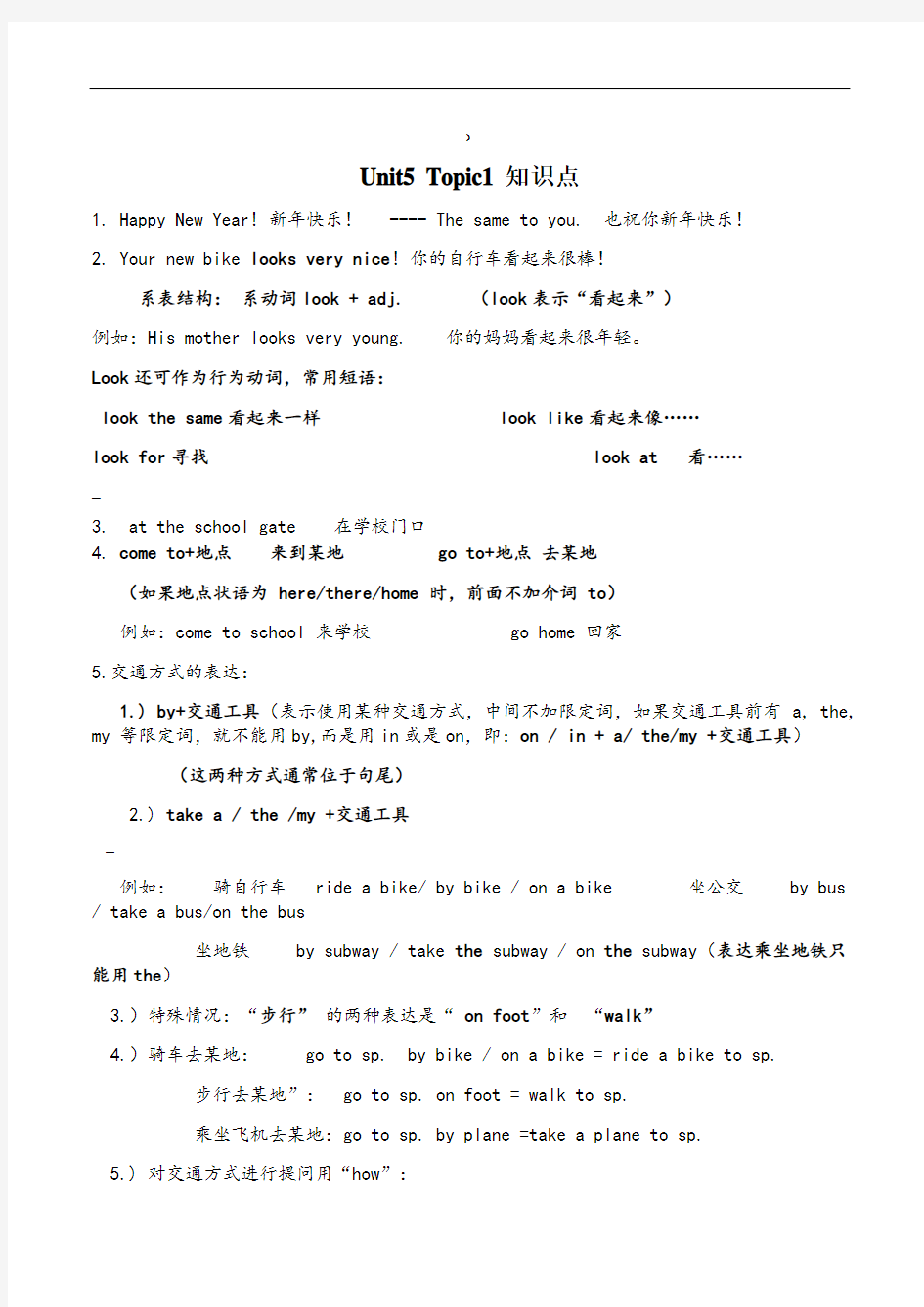仁爱英语七年级下册unit5topic1知识点


)
Unit5 Topic1 知识点
1. Happy New Year! 新年快乐! ---- The same to you. 也祝你新年快乐!
2. Your new bike looks very nice! 你的自行车看起来很棒!
系表结构:系动词look + adj. (look表示“看起来”)
例如:His mother looks very young. 你的妈妈看起来很年轻。
Look还可作为行为动词,常用短语:
look the same看起来一样 look like看起来像……
look for寻找 look at 看……
—
3. at the school gate 在学校门口
4. come to+地点来到某地 go to+地点去某地
(如果地点状语为 here/there/home 时,前面不加介词 to)
例如:come to school 来学校 go home 回家
5.交通方式的表达:
1.) by+交通工具(表示使用某种交通方式,中间不加限定词,如果交通工具前有a, the, my 等限定词,就不能用by,而是用in或是on,即:on / in + a/ the/my +交通工具)
(这两种方式通常位于句尾)
2.) take a / the /my +交通工具
—
例如:骑自行车 ride a bike/ by bike / on a bike 坐公交 by bus / take a bus/on the bus
坐地铁 by subway / take the subway / on the subway(表达乘坐地铁只能用the)
3.)特殊情况:“步行”的两种表达是“ on foot”和“walk”
4.)骑车去某地: go to sp. by bike / on a bike = ride a bike to sp.
步行去某地”: go to sp. on foot = walk to sp.
乘坐飞机去某地:go to sp. by plane =take a plane to sp.
5.) 对交通方式进行提问用“how”:
例如:How do you usually come to school 你通常怎样来学校…
—I usually come to school by subway. 我通常乘坐地铁来学校。
6. how often 表示“多久一次”(对频度进行提问)
频度的表达方式:
1.)常用频度副词always> usually>often> sometimes>seldom>never
(注意:频率副词在句中常放在be动词,情态动诃,助动词之后,行为动词之前。
例如:She is always busy with her work.她总是忙于工作。
He often gets up at 6 in the morning 他经常早上六点钟起床。)
2.)表示频率的短语:次数+单位时间
【
(次数的表达方法1.“一次”once,“两次”twice; 2.表达三次或三次以上时用“数词
+times”)
例如: once a week一周一次 three times a year每年三次How often do you go to the library 你多久去一次图书馆
--once/twice/three times/four times a week/month/year
7.get to + 地点到达某地例如:get home到家
8. It’s time for class. 该上课了。
It’s time for sth. = It’s time to do sth. 该做某事了。
例如:It’s time for school. = It’s time to go to school. 该上学了。
》
9. do one’s homework 做某人的家庭作业例如:do my homework 做我的作业
have a class / have classes 上课 have an English class 上英语课
10. get up 起床 get up early 早起
go to bed 睡觉 go to bed early早睡
例如:We should go to bed early and get up early. 我们应该早睡早起。
11. go+ 表示去做某事
例如:go fishing 去钓鱼 go shopping 去购物 go boating 去划船
12. in one’s free/ spare time 在某人的空闲时间例如:in my free/ spare time 在我的空闲时间
|
13. come on 快点,加油,来吧 watch TV 看电视 at school 在学校
on weekdays 在平日on weekends在周末on Sundays 在每个周日
know about / learn about 知道,了解school life 校园生活
an American student 一个美国学生
the school life of American students 美国学生的校园生活
in America / in the 在美国 for a short time 一会儿 every day每天
after class 课下after dinner 晚饭后after school 放学
play basketball 打篮球 play soccer / football 踢足球(进行球类运动则不带the)
:
listen to music听音乐 read books读书 meet friends见朋友
have breakfast 吃早饭 have lunch吃午饭 have dinner 吃晚饭
go to the zoo去动物园 go to the park去公园 go to the library去图书馆
in the morning 在早上 in the afternoon 在下午 in the evening 在晚上
14. The early bird catches the worm. 早起的鸟儿有虫吃。/ 笨鸟先飞。
15. be over 结束例如:What time is school over 几点放学
Class is over.下课。
different from 与……不同,不同于……
例如: The new book is different from the old one. 这本新书不同于那本旧的。
【
时间表达法:
1.) 顺读法:先读点钟再读分钟。
①整点:点钟+ o’clock (o’clock可以省略。) 例如:3:00 three
o’clock 或者 three
②当0<分钟<10时:点钟 + O + 分钟例如:6:05 six o five
③当10≤分钟<60时:点钟 + 分钟例如:8:26 eight twenty-six
2.) 逆读法:先读分钟再读点钟。
①整点:点钟+ o’clock (o’clock可以省略。) 例如:3:00 three
o’clock 或者 three
—
②当0<分钟≤30时:分钟 + past + 钟点即“几点过几分”
例如:7:22 twenty-two past seven
③当30<分钟<60时:(60 - 分钟) + to + (钟点 + 1) 即“差几分到几点”
例如:9:55 five to ten
④整刻钟:一刻钟(即15分) a quarter past + 点钟
三刻钟(即45分) a quarter to + (点钟 + 1)
例如:1:15 a quarter past one 10:45 a quarter to eleven
⑤半点(即30分):half past + 点钟例如: 11:30 half past eleven
(
一般现在时
1.)表示现在的状态。例如: My name is Jane. I am a student. 我叫简。我是学生。
2.)表示经常的或习惯性的动作。例如:Kangkang goes to school on bike. 康康骑自行车
上学。
3.)表示特征或能力。例如:He can play soccer. 他会踢足球。
4.)表示客观真理。例如:The earth goes around the sun. 地球围绕着太阳转。
(一)be动词的一般现在时的句式:
肯定句:主语 + be + 其他。例如:She is Maria. 她是玛利亚。
。
否定句:主语 + be + not + 其他。例如:She isn’t Maria. 她不是玛利亚。
一般疑问句:Be + 主语 + 其他
肯定回答:Yes, 主语 + be. 否定回答:No, 主语 + be + not.
例如: Is she Maria 她是玛利亚吗
Yes, she is. 是的,她是。 No, she i sn’t. 不,她不是。
特殊疑问句:特殊疑问词 + be + 主语 + 其他(即:特殊疑问词 + 一般疑问句)例如:Who is she 她是谁
(二)行为动词的一般现在时的句式:
`
(注意:当谓语动词是行为动词时,要用助动词do 或does帮助构成疑问句和否定句。)
1.)肯定句:主语 + 动词原形 / 动词的单三形式 + 其他。
I come from America. 我来自美国。
2.)否定句:主语+ don’t / doesn’t + 动词原形 +其他。
I don’t come from America. 我不是来自美国。
3.) 一般疑问句:Do / Does + 主语 +动词原形 +其他回答: 肯定回答:Yes, 主语+do / does.
否定:No, 主语+don’t / doesn’t.
Do you come from America 你来自美国吗 Yes, I do. / No, I don’t .
\
4.)特殊疑问句:特殊疑问词+do / does + 动词原形 +其他(即:特殊疑问词+一般疑问句)
Where do you come from 你来自哪里
(三) 一般现在时中,如果谓语动词是“情态动词+动词原形”,其句式变化是:
肯定句:主语 + 情态动词 + 动词原形 + 其他。
例如:I can see pandas at the zoo. 在动物园我能看到熊猫。
否定句:主语 + 情态动词 + not + 动词原形 + 其他。
例如:I can’t see pandas at the zoo. 在动物园我不能看到熊猫。(can not = can’t)
疑问句:情态动词 + 主语 + 动词原形 + 其他
肯定回答:主语 + 情态动词。否定回答:主语+ 情态动词 + not 。
例如:Can you see pandas at the zoo 在动物园你能看到熊猫吗
Yes, I can. 是的,我能。No, I can’t. 不,我不能。
特殊疑问句:特殊疑问词 + 情态动词 + 主语 + 动词原形 + 其他
(即:特殊疑问词+一般疑问句)
例如:What can you see at the zoo 在动物园你能看到什么
(注意:①有些情态动词的一般疑问句的回答有特殊情况,需要在日后的学习中积累,目前我们所学的can ,will都按这种句式变化。②情态动词没有人称和单复数的变化,后面必须加动词原形。)
